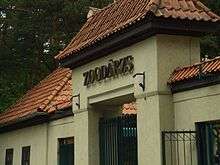Riga Zoo
|
| |
 Entrance | |
| Date opened | 14 October 1912 |
|---|---|
| Location | Riga, Latvia |
| Coordinates | 57°00′22″N 24°09′27″E / 57.006111°N 24.157500°ECoordinates: 57°00′22″N 24°09′27″E / 57.006111°N 24.157500°E |
| Land area | 16.4 ha (41 acres)[1] |
| No. of animals | 3270 |
| No. of species | 486 |
| Memberships | EAZA[2] |
| Website | rigazoo.lv/public/index_en.html |
Riga Zoo is a city-owned zoo in Riga, Latvia. It is located in Mežaparks, on the western bank of Ķīšezers lake. Riga Zoo houses around 4000 animals of nearly 500 species and is visited by 250-300,000 visitors annually. The zoo has a branch "Cīruļi" in Liepāja District, Kalvene parish, established in 1996, it has an area of 135 hectares (330 acres).
History
In 1908 a society was established to coordinate the formation of the zoo, and in April 1911, 16.4 ha (41 acres) of land was allocated for this purpose. The zoo was opened to the public on 14 October 1912; it housed 267 animals of 88 species at the time. Many animals were donated to the zoo; in 1914, the zoo received 538 animals.
During World War I the zoo experienced hardships and closed in August 1917 after German army occupied Riga city; after the war a camp for children of low income families was established at the site. On 29 December 1932 a society was established, which renewed the zoo and it was reopened on 24 September 1933 housing 124 animals of 48 species; by 1938 number of species had increased to 106.
During World War II the development of the zoo stalled; however, animals and buildings of zoo were preserved and on 9 November 1944 the zoo was opened to the public again. After the war, the zoo experienced rapid growth and was considered one of the best zoos in Soviet Union. In 1950, an aquarium was created and in 1955 a tour guide service was created. However, construction of new housing for the animals failed to match the growth of the zoo, new housing, such as a flamingo house and a bear house, were built in 1980-1985. In 1987, the zoo housed 2150 animals of 401 species. In 1988 the zoo began work on the reintroduction of the European tree frog; as a result, the species now can be found in the wild in many parts of Courland.
After Latvia regained its independence in 1991, the zoo experienced hard times as the number of visitors, which had ranged from 250-300,000 visitors annually, was reduced to some 110,000. To attract visitors, the zoo began several development projects and worked on public relations and now the number of visitors is once again about 250-300,000 annually. In 1992, the zoo joined the European Association of Zoos and Aquaria. In 1996 zoo established an affiliate "Cīruļi". Several new animal houses have been built in 1990s and 2000s. In 2002, an additional 0.035 km2 of land was incorporated into the zoo.
Current development
The zoo offers various sponsorship options and states that it will accept any kind of sponsorship, except if it contradicts the goals of the zoo - humane handling of animals, no trading or hunting of wild animals - or promotes addiction-forming products. One can become an honorary guardian of an animal by donating 10 Latvian lats or more; by becoming a guardian, a person or company receives plaque inscribed with their name or logo placed next to the funded animal. Sponsors who have donated more than 500 lats also receive a plaque in a stand near the central entrance of zoo. If many sponsors have contributed to building of an animal house, a stand listing all sponsors may be place at the animal house in question. Sponsors who have contributed more than 50% of funding for animal house can also name the building.
Research projects and conservation efforts
Riga Zoo enacts several scientific research and wild life conservation projects.
Monitoring of owl autumn migration
Owls are monitored since 1985 in Pape. The aim of the project is to collect information of owl migration in northern Europe and compare annual differences. Owls are trapped to determine their species, the number of young birds and other data. Birds are ringed and set free.
Reintroduction of European tree frog in Latvia
This project was started in 1988 in southwestern Courland, where a wildlife reserve was established for the purpose. The project aims to reintroduce the European tree frog, which had become extinct in Latvia decades before project begun. In 1988-1992 more than 4000 young frogs were released in wild; by 2001 about five generations of frogs had bred in the wild and 110 distinct frog colonies existed.
Vulture breeding project
A breeding complex was established in the zoo's affiliate "Cīruļi" in 2000. White-tailed eagles, lesser spotted eagles, peregrine falcons, barn owls and Eurasian eagle-owls are bred to reintroduce these species in Latvia and extend existing populations.
Research of lesser spotted eagle behaviour traits
As most studies of lesser spotted eagle in Latvia have been made to research their habitat range and population, this project aims to learn more about various habits of lesser spotted eagles by visually monitoring and recording their actions.
Entomology research
Riga Zoo researchers have participated in various entomology expeditions since 1989. In 1989-1993 expeditions were made to various places in the former Soviet Union (Ukraine, Central Asia, Azerbaijan, Southern Siberia, Primorsk, Sakhalin and Kunashir Island). Since 1994, Riga Zoo has participated in six expeditions to Vietnam, where ten new species have been found during these expeditions.
See also
Notes
- ↑ "A Day at the Zoo(dārzs)". latvians.com. Latvians.com. Retrieved 19 March 2011.
- ↑ "EAZA Member Zoos & Aquariums". eaza.net. EAZA. Retrieved 19 March 2011.
External links
 Media related to Riga Zoo at Wikimedia Commons
Media related to Riga Zoo at Wikimedia Commons- Official website
